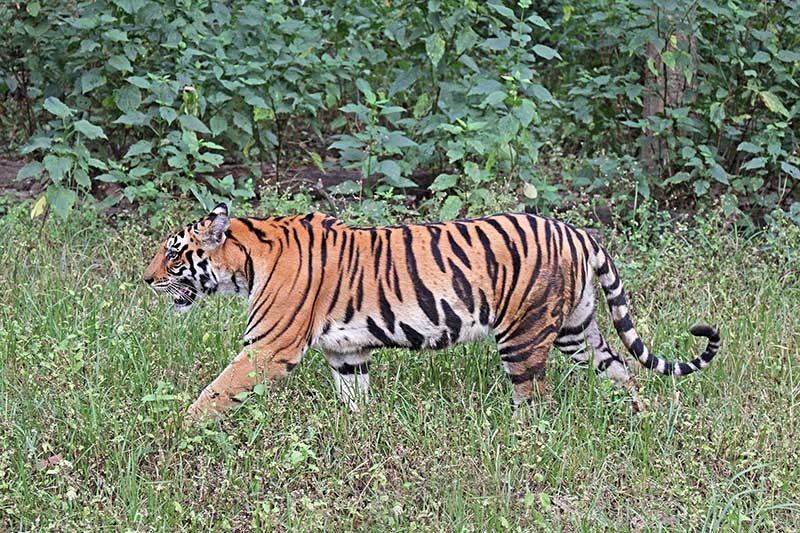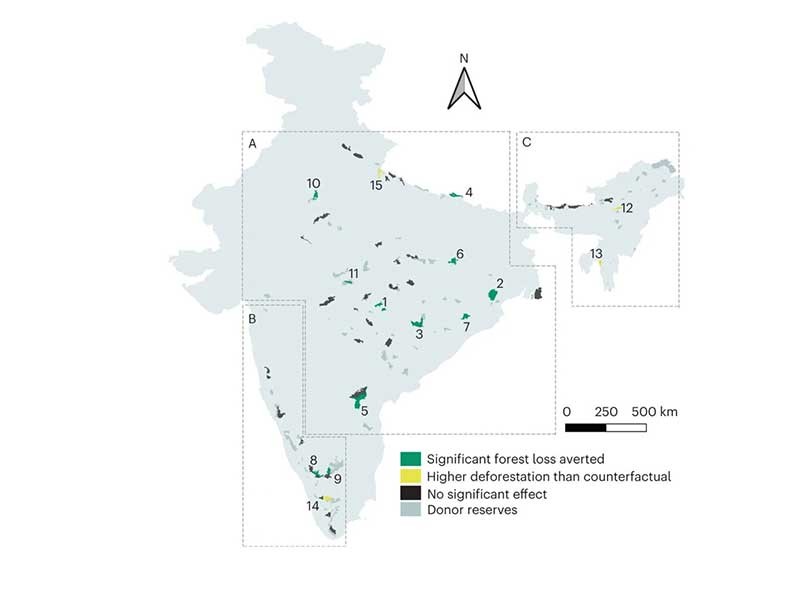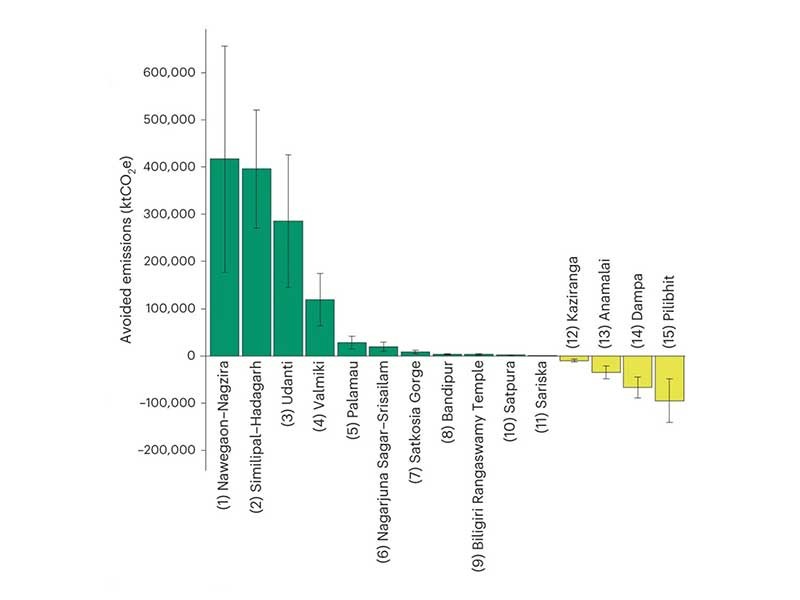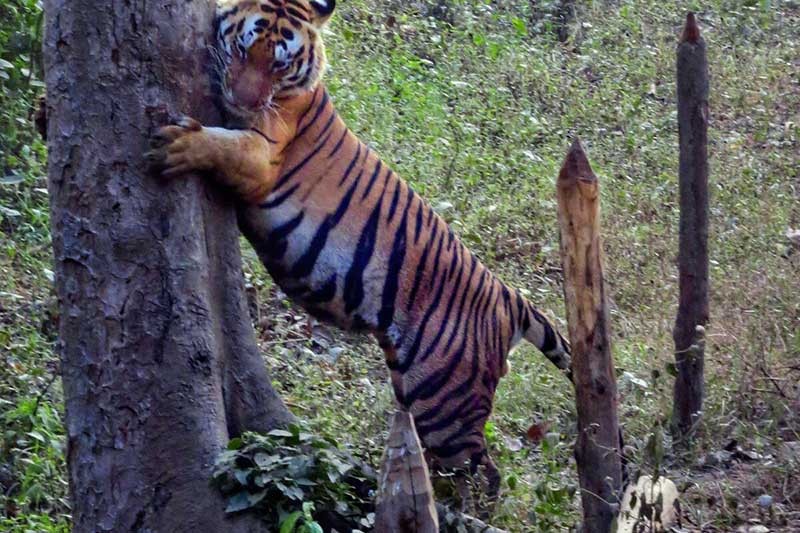 Tiger
A young tigress in Kanha Tiger Reserve / Wikipedia Creative Commons
Tiger
A young tigress in Kanha Tiger Reserve / Wikipedia Creative Commons
Indias tiger reserves have helped fight climate change
Enhanced conservation management of tiger reserves in India has helped avoid forest loss, preventing one million metric tons of carbon dioxide equivalent emissions. This represents $93 million in ecosystem services from the avoided social cost of emissions. The researchers suggest that biodiversity conservation programmes could generate revenue from carbon credits that could be traded in voluntary carbon markets. Mongabay-India writer Neha Jain reports
New research shows that India’s tiger conservation policy has not only helped in preserving and increasing tiger populations, but it has also played a role in climate change mitigation by avoiding forest loss.
India is home to more than 70 percent of the world’s endangered tiger population. In 2005, the National Tiger Conservation Authority (NTCA) was established and key protected areas were designated as tiger reserves across India, which had enhanced protection and monitoring. By the end of 2022, around 53 tiger reserves across India were under enhanced management. Reserves under this policy are required to prepare a conservation plan regulating the extraction of forest products, reducing deforestation drivers and encouraging alternative livelihoods for communities that live within tiger conservation landscapes.
The researchers modelled forest loss and the associated carbon emissions reductions in 45 tiger reserves that were under enhanced protection from 2007 to 2020 compared with 117 untreated protected areas.
“Our study is one of the first to quantify the additional carbon benefits of a species conservation program at a large geographical scale,” says Aakash Lamba, a doctoral candidate at the National University of Singapore and lead author of the study.
Published in Nature in May 2023, the study found that between 2007 and 2020, enhanced protection within tiger reserves led to a net avoided forest loss of over 5,802 hectares — corresponding to approximately 1.08 million metric tons of carbon dioxide equivalent emissions (MtCO2e).
This translated to $93 million in ecosystem services from the avoided social cost of emissions, which is the additional damage that the Indian economy would have faced had these emissions been released into the atmosphere. This estimate corresponds to about $7 million per year between 2007 and 2020. The annual budget from Project Tiger in 2020 was $27 million. So, more than a quarter of this budget was paid back per year from the avoided social cost of emissions.
“A crucial takeaway from our findings is that biodiversity conservation can help pay for itself given the ancillary climate and consequently economic benefits arising from these programs,” Lamba points out. These findings, he says, “offer empirical evidence that conservation efforts targeted at umbrella species such as tigers can have a significant and positive ripple effect on climate change mitigation.”
He adds that, “By adopting effective conservation strategies such as the ones implemented in tiger reserves across India, policymakers and managers can leverage effective protected areas as an additional part of their toolkits to meet climate targets.”
“The paper shows the remarkable success of investments in Tiger Reserves in India for protecting habitat within these protected areas, as has been found in other places around the world,” says Ruth DeFries, professor of ecology and sustainable development at Columbia University, who was not connected to the study. “The investment has also benefited the national goal of carbon sequestration.
An equally critical need is to manage areas outside protected area boundaries to meet multiple goals of minimizing conflict with people, enabling livelihoods, sequestering carbon and providing habitat for biodiversity over larger areas,” stresses DeFries.
Central India versus the Northeast
The study found that 15 out of 45 tiger reserves showed significant but mixed results on deforestation. Overall, the designation of tiger reserves had a net positive impact on forest protection with 11 out of 15 reserves avoiding deforestation. Reserves in Central India showed higher avoided forest loss with Nawegaon–Nagzira Reserve emerging as the best-performing reserve. Four reserves, however, showed higher forest loss than the control models. Two of these reserves fall in Northeast India.
 Locations of the tiger reserves and the forest loss avoided. Photo from Lamba et al., 2023.
Locations of the tiger reserves and the forest loss avoided. Photo from Lamba et al., 2023.
Deforestation in reserves in northeastern India is highly complex and averting forest loss will involve a myriad of interventions. According to Lamba, “making sure that local communities both benefit from protected areas and are key partners in the decision-making process for conservation programs is essential for equitable and effective forest conservation.”
Forest conservation can be strengthened for the benefit of local communities and ecosystems “by prioritizing community engagement, alternative livelihoods, social assistance, cultural respect, technological monitoring, and adaptive management,” Lamda adds.
Generating climate finance through carbon credits
According to the authors, these findings suggest that integrating species conservation programmes into global carbon markets could provide additional opportunities for funding the protection and restoration of natural habitats.
Carbon markets are well-established trading systems where carbon credits, representing a reduction or removal of greenhouse gas emissions, are bought and sold. They are issued to organizations or individuals that have taken measurable steps to reduce their carbon footprint, explains Lamba. In recent years, the voluntary carbon market has grown rapidly with nature-based climate solutions such as forest protection and restoration.
 Carbon emissions avoided by the tiger reserves analysed. Photo from Lamba et al., 2023.
Carbon emissions avoided by the tiger reserves analysed. Photo from Lamba et al., 2023.
Lamba stresses that the idea of ‘additionality’ is important to understand the discussion on carbon markets. “Additionality refers to the requirement that an intervention creates additional or extra climate benefits compared to the business-as-usual scenario. Under the current definition of additionality, the avoided emissions from tiger reserves may not be eligible for the generation of carbon credits given that these reserves are already protected,” he explains.
“However, our study provides food for thought on how this idea of additionality may be expanded since we see that improvements in the management of already protected areas do in fact yield additional climate benefits. By quantifying these carbon benefits, our study shows how biodiversity conservation programs could generate revenue from carbon credits that could be traded in voluntary carbon markets. The revenue generated from the sale of these carbon credits could be reinvested back into conservation, creating a more sustainable model for financing biodiversity conservation programs.”
 Tiger in Kanha Tiger Reserve. Photo by David Wilcove.
Tiger in Kanha Tiger Reserve. Photo by David Wilcove.
Limitations of the study
Ghazala Shahabuddin, visiting professor at Ashoka University, who was not part of the study, believes that tiger conservation does not represent a useful co-benefit for carbon sequestration in India’s protected area landscape.
She questions the use of remote sensing in detecting forest loss as a surrogate for biodiversity or even carbon sequestration benefits. “It is well-known that both biodiversity and carbon sequestration ability are adversely affected not only by net forest loss but also by forest degradation and conversion to monocultures. However, neither degraded forest area nor tree-based monocultures are easily detectable with the help of satellite imagery; such land uses can show up as forest of varying canopy covers,” notes Shahabuddin.
“This problem of detectability also means that actual losses as far as biodiversity is concerned, could in fact be higher than inferred from net forest loss estimates alone. Therefore, I would recommend much more ground-truthing in a sample of tiger reserves from each biome in such studies.”
Further, Shahabuddin says that “even if we assume that remotely sensed forest cover is a good surrogate for biodiversity or carbon, the total carbon corresponding to avoided forest loss from tiger conservation is estimated only at 1.08 MtCO2e,” which, she points out, “is a very tiny fraction of the estimated annual carbon emissions in the country as of 2020 of 3.17 GtCO2e (Gigatonnes of equivalent carbon dioxide).”
 Nagzira Lake. Nawegaon–Nagzira Tiger Reserve showed the highest averted forest loss (2,645 ha) since its notification as a tiger reserve in 2013, the study finds. Photo by Anweshanna/Wikimedia Commons.
Nagzira Lake. Nawegaon–Nagzira Tiger Reserve showed the highest averted forest loss (2,645 ha) since its notification as a tiger reserve in 2013, the study finds. Photo by Anweshanna/Wikimedia Commons.
Lamba acknowledges that the study focuses on deforestation, which represents the complete loss of forest cover in an area. “Forest degradation and changes in forest structure could also represent an important driver of forest carbon loss,” he explains, adding that their “estimates provide a conservative measure of carbon emissions avoided, as preventing forest degradation in these tiger reserves could result in even higher emissions reductions.”
The authors point out another caveat. “The carbon benefits discussed primarily apply to species found in high-carbon ecosystems such as terrestrial forests, limiting the generalizability of a biodiversity-first paradigm,” Lamba says. “However, since many high biodiversity areas coincide with carbon-rich protected areas, it becomes crucial to conduct such evaluations to establish an evidence base for directing more resources towards species conservation programmes.”
Top Headlines
-
Environment
From Dust to Life: How Tal Chhapar Became Indias Grassland Revival Blueprint
December 18, 2025
-
Environment
From Nets to Lifelines: The Rising Whale Shark Rescue Movement Across Indias West Coast
November 29, 2025
-
Environment
Indi Setu: Wildlife on the Brink: Can We Rewild a Warming World?
October 25, 2025
-
Environment
SonaSPEED motors power NASAISRO synthetic aperture radar mission
August 01, 2025
-
Environment
How green is my city
July 01, 2025
-
Environment
India's River Dolphin: Clear And Present Danger
May 28, 2025
-
Environment
South Kashmir The costs of coexisting with predatory wildlife
May 12, 2025
-
Environment
Sariska Tiger Reserve: A maharani recognised
May 02, 2025
-
Environment
Arunachal Pradesh: Retracing a century-old biodiversity in Siang Valley
April 03, 2025
-
Environment
Toxic air and smog choke Delhi as experts at COP29 in Baku warn how dragging feet on fossil fuel reduction can cause catastrophe
November 19, 2024

